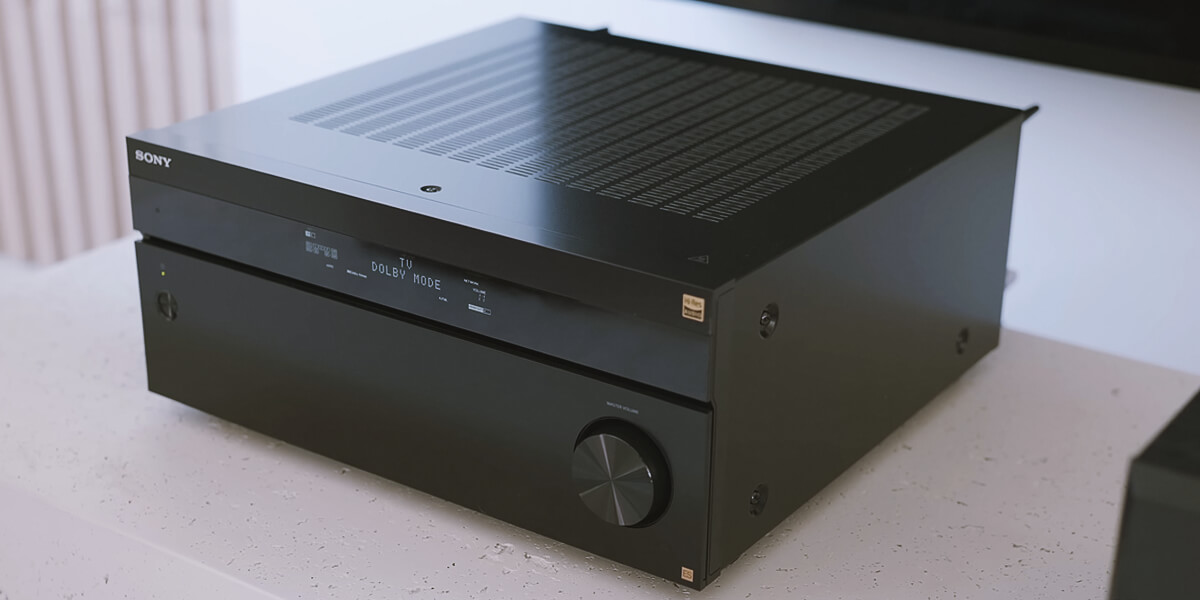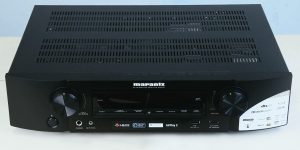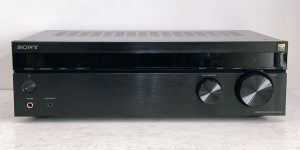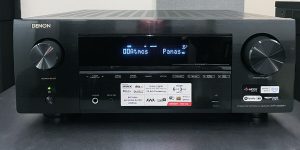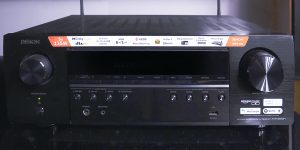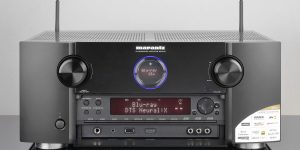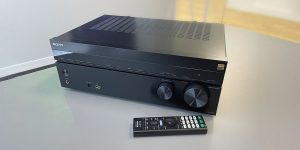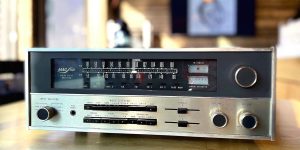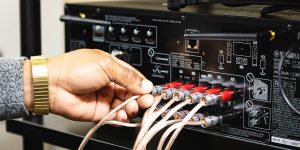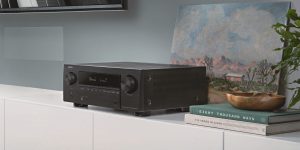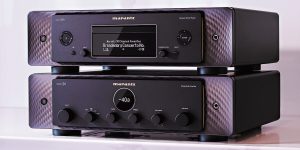When you talk about 11 channels of surround sound, everyone understands that they mean high-end home theater receivers. So, if you have already reached a level and set aside enough money to buy an audiophile sound system, you will find it useful to read my five high-end devices and choose the best 11.2 receiver for yourself.
You will see that each model in this review is modern and advanced and will satisfy even the most experienced user. Even though an 11-channel system is expensive, in this article, you will find AVRs with different costs so that you can find a model for every budget. And first, I will give you a general idea about the system and what you can expect. So let’s get started.
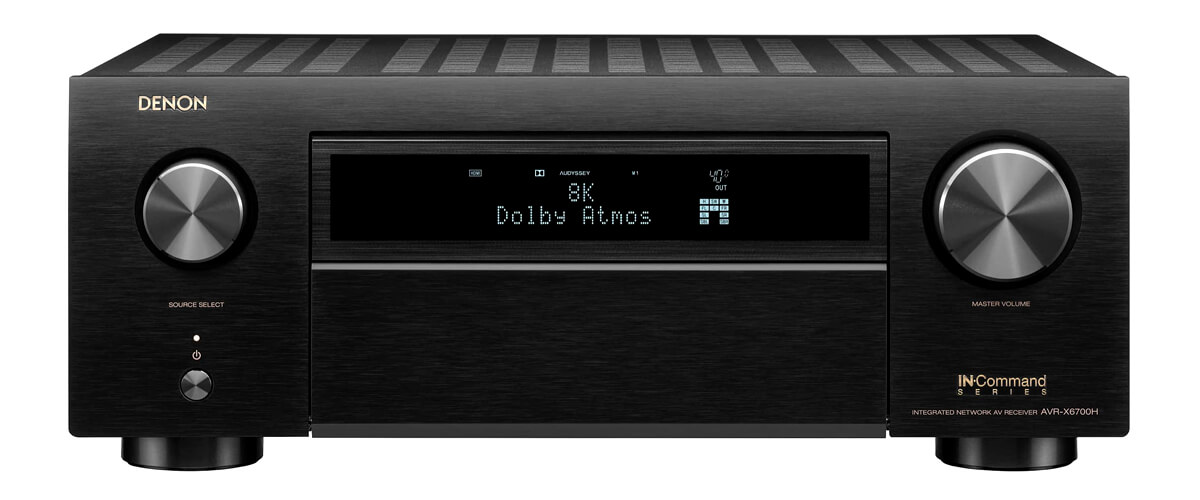
11 channel AV receivers comparison table
| Name | Channels | Power output | HDMI in/out | Bluetooth/Wi-Fi | Review |
|---|---|---|---|---|---|
| Denon AVR-X6700H best overall | 11.2 | 140W/8 Ohm, 175W/6 Ohm | 8/3 | yes/yes | Review |
| Marantz SR8015 also great | 11.2 | 140W/8 Ohm, 175W/6 Ohm | 8/3 | yes/yes | Review |
| Pioneer Elite VSX-LX505 | 11.2 | 120W/8 Ohm, 230W/6 Ohm | 7/2 | yes/yes | Review |
What is an 11.2 receiver, and why do I need one?
You need an 11.2 receiver if you are an experienced home theater user who appreciates improved surround sound, video quality, and advanced features.
It’s worth realizing that you’ll need a lot of space to set up and evenly sound the 11.2 AVR, so I recommend placing these units in a spacious room where additional speaker channels can effectively create a surround sound scene. Typical 11.2 system configurations include 7.2.4 or 9.2.2.
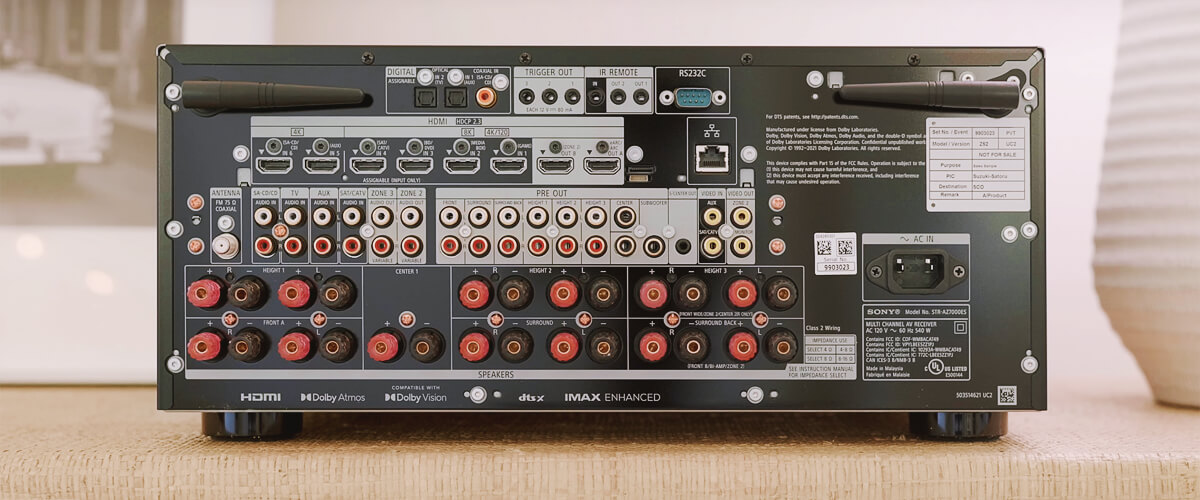
The benefits of an 11.2 receiver for your home theater setup
The 11.2 receiver offers several essential benefits for your home theater experience:
Improved sound perception: With more channels, the 11.2 receiver delivers more immersive and realistic sound, creating a sense of depth and dimension in movies and games.
High-rise and object sound: Additional channels can be used for high-rise speakers or object-oriented formats such as Dolby Atmos and DTS:X, which create a three-dimensional soundstage for an even more immersive listening experience and further enhance the visuals.
Flexible speaker configurations: The 11.2 receiver allows various speaker placement options based on room size, layout, and personal preferences.
Future-proof: Investing in the 11.2 receiver guarantees compatibility with current and emerging surround sound, audio, and video formats providing a future-proof solution for your home theater system.
What are some common features found on high-end 11.2 receivers?
In addition to 8K video and surround sound in Dolby Atmos and DTS:X formats and variations thereof, high-quality 11.2 receivers are often equipped with various features, such as advanced room correction software, advanced connectivity (more HDMI ports for top-quality signals), support for Hi-Res audio formats, built-in streaming services, voice assistants and ecosystems for wireless audio throughout the home.
Non-obvious points to keep in mind when choosing an 11.2 AVR
I offer a review of 11 channel receivers, among which there are no “budget” or “compromise” ones. On the contrary, all of them combine the highest qualities inherent in the models of the premium category. So I want to draw your attention to the non-obvious points which can affect your overall impression and satisfaction with your chosen AVR.
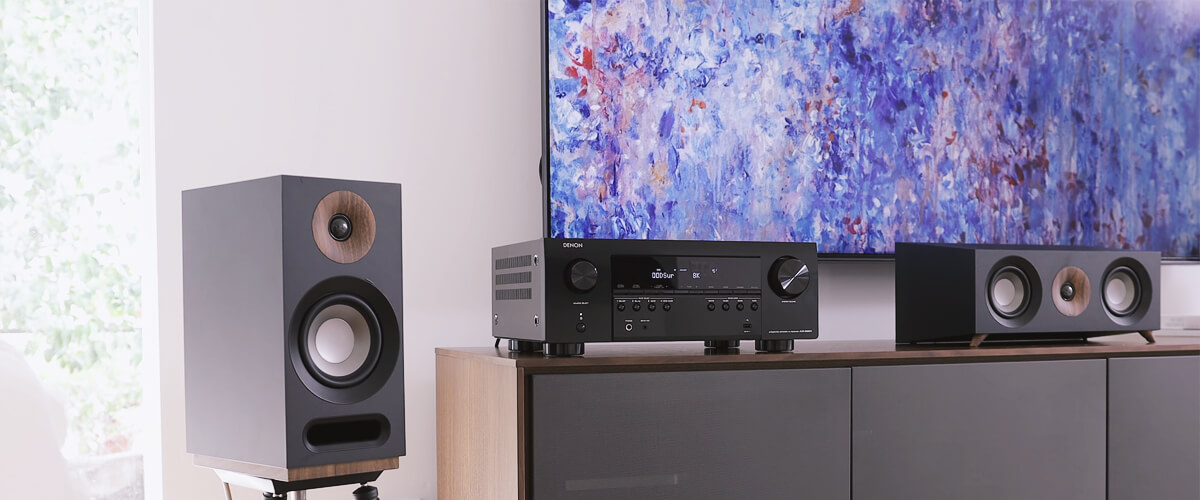
Build quality
High-quality components and construction provide durability and longevity and contribute to better audio and video playback. For example, the weight of the receiver provides anti-resonance. Rugged cabinet and regulator materials are important for durability. I recommend paying special attention to the vents (are they large enough to ensure the receiver is stable).
Expandability
Although such models already support many channels, I would consider expanding for future upgrades or additional zones. Some receivers may have pre-outs for connecting external amplifiers, which can be useful if you plan to expand your system or want more power for demanding speakers. Other receivers may have multi-zone functionality, allowing you to distribute audio and video to different rooms or areas of your home.
Power consumption
While power consumption may not be the first thing that comes to mind when choosing an 11.2 High-End audio-video receiver, I think it is important to consider its potential impact on your energy bills. Therefore, look for AVRs with power-saving features or “Eco” mode, which can help reduce power consumption without significantly reducing performance.
Warranty, support, and brand reputation
Finally, when choosing an 11.2 AVR, consider the brand’s reputation. After all, you’re making a big investment, which means it’s worth protecting yourself in case the receiver breaks, right? Brand reputation is very important because leading companies value it and create quality products. But in the case of defects can provide decent warranty service. Also, such manufacturers usually have a responsive and professional support team whose members will help you to solve the issue of fixing or replacing the receiver quickly and qualitatively.
Best 11-channel receiver reviews
Denon AVR-X6700H – best overall

My rating opens with the 2020 top receiver with 11.2 channels, Denon AVR-X6700H. This model combines all the qualities of modern equipment, and the price is slightly more affordable than some competitors. And that gave me the right to give it the top spot on my list since its configuration can also be expanded to 13 channels.
So, it’s a heavy (32 pounds), well-built receiver with 140 watts of power (8 ohms, 20 Hz – 20 kHz, 0.05% 2ch). You can crank up the full volume with it, as it offers an excellent THD for this category.
Key features of the X6700H include a large number of HDMI ports (8 inputs, including one frontal, which is very convenient, and 3 outputs) that support HDCP2.3, CEC, ARC/eArc, VRR, and ALLM. It means getting high-quality 8K/60Hz or 4K/120Hz and Upscaling and 3D Signal Pass-through for Blu-ray DVDs, Xbox video consoles, PS, Nintendo, and more. And component inputs (coaxial, optical, digital), a phono input, and a Multi-Room option for 3 Zones. And here, I would note that the receiver’s performance for movies in the extra zone in stereo mode is worth separate praise. I often encounter other models with the inability to downgrade the surround sound to stereo, and there were no problems here. So, for example, you can watch movies in the kitchen in normal mode.
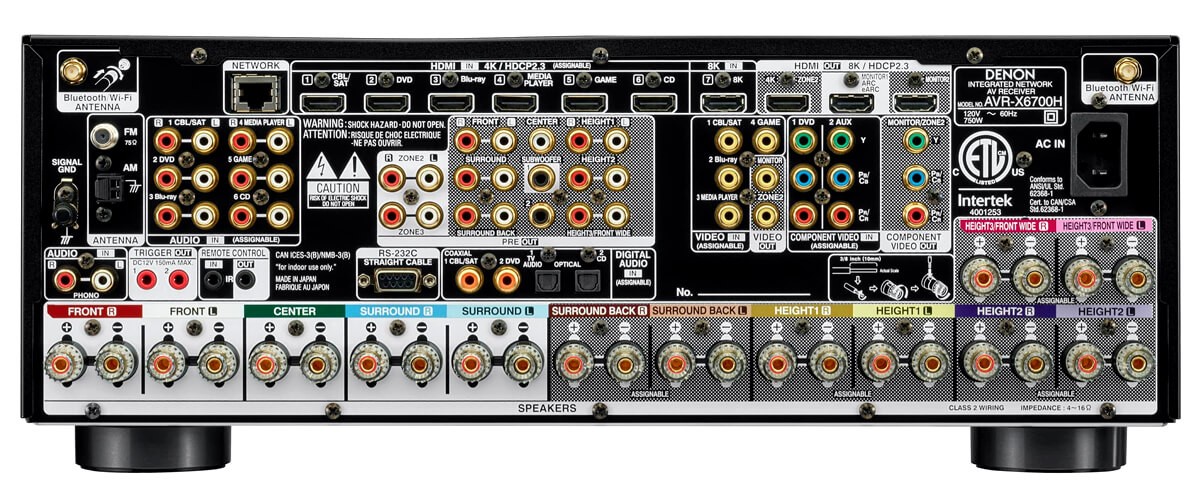
For video, the AVR-X6700H gives you access to Dolby Vision and HDR10+ formats. And surround sound in Dolby Atmos, DTS:X (incl Pro), DTS Neural:X, IMAX Enhanced, and Auro-3D. That’s pretty much all the formats of the day.
Of the extras, you have wireless connectivity, built-in streaming services (some it just works with), AirPlay2 compatibility, and a built-in HEOS ecosystem. And all this with audio in Hi-Res.
When I calibrated the Denon AVR-X6700H with its Audyssey MultEQ XT3 (which is very handy, by the way) and turned on the Harry Potter and the Prisoner of Azkaban movie, already in the bus scene, the possibilities became clear. The mysterious whisper of the conductor, the police sirens in the background, the grinding of the wheels – everything was exactly where it was supposed to be, clearly audible and immersed in the center of the events. Very good signal separation and detail. Although, frankly, the receiver has less bass response than the competitors. And separately, I would like to mention the user interface, which is as simple as possible. Even a child can cope with it.
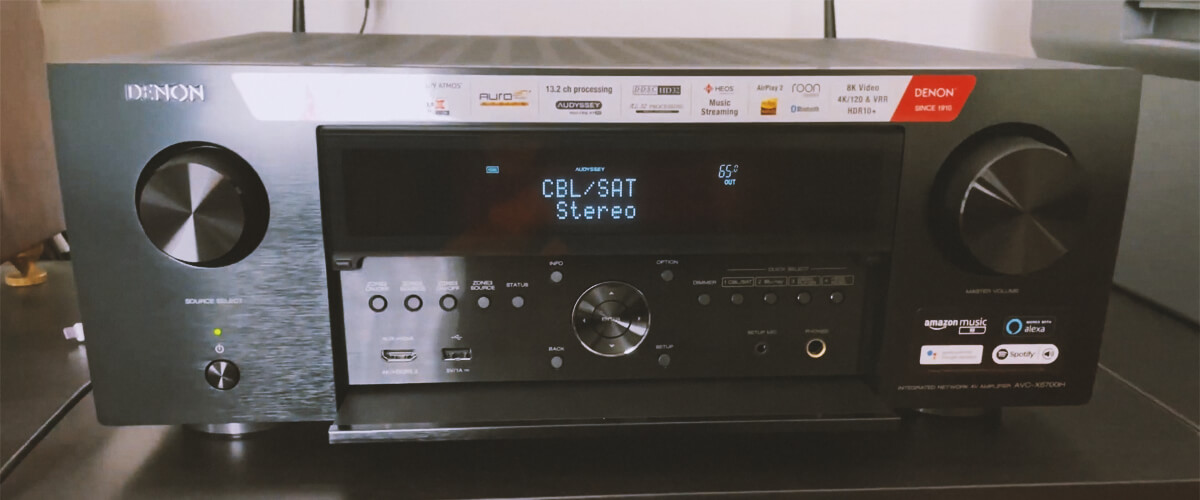
On the other hand, the wireless digital streaming via the AV input disappointed me a little. I heard a noticeable delay between the main unit and the wireless speakers. On the other hand, with the Sonos, there was no such problem, and the sound was stable and of high quality.
The Denon AVR-X6700H is the best 11-channel receiver on my list because it offers an excellent combination of great sound, functionality, and lower cost than other high-end models.
Key specs
- Channels: 11.2.
- Power output: 140W/8 Ohm, 175W/6 Ohm.
- HDMI inputs/outputs: 8/3.
- Video functions: 8K/60Hz, 4K/120Hz pass-thorugh, upscaling to 8K.
- Bluetooth/Wi-Fi: yes/yes.
- Streaming services: AirPlay 2, Spotify, TuneIn, Deezer, Tidal, Netflix, Amazon Prime.
- Supports: HDMI ARC, HDMI eARC, HDMI CEC, HDCP2.3, HDR10+, Dolby Vision.
- Surround sound: DTS:X, DTS Neural:X, DTS:X Pro, DTS HD Master, Dolby Atmos, Dolby TrueHD, Dolby Atmos Height Virtualization, Dolby Surround, IMAX Enhanced, Auro 3D.
Pros
- Lowest THD of 0.05% for 8 Ohms compared to other models on the list.
- The user interface is intuitive and incredibly simple.
- Excellent video and stereo transmission to the second zone.
- Gamers-targeted.
- The receiver recreates a unique holistic sound scene in which dialogue, music, sound effects, and bass are reproduced organically and incredibly accurately.
Cons
- Less bass than competitors.
- Noticeable sound delay when using wireless speakers with AV input (poor HEOS performance).
Marantz SR8015 – also a great choice
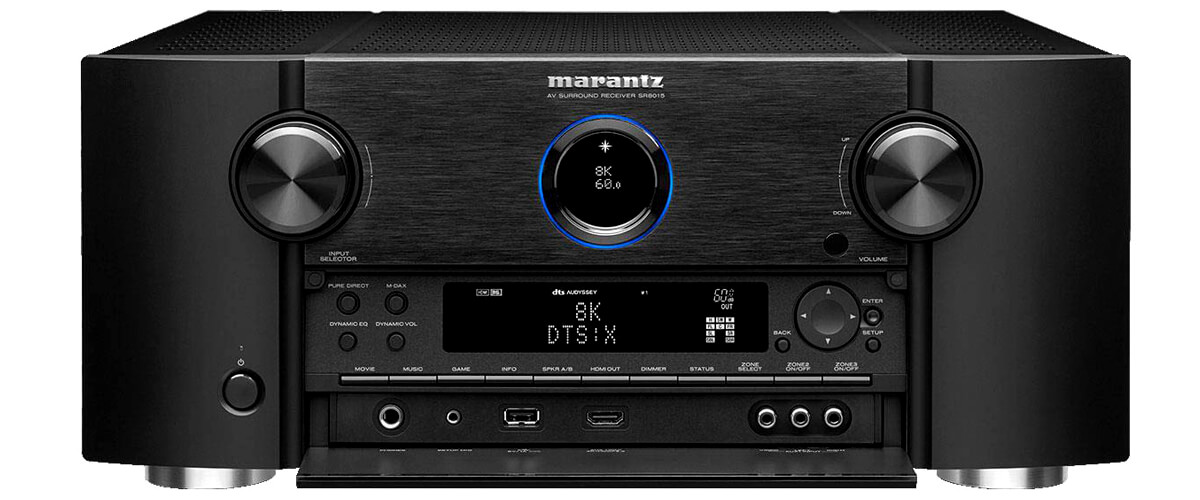
Another high-end AV receiver in this category is the Marantz SR8015, released in 2020 and just like a twin brother to the Denon AVR-X6700H, up to the system’s expansion to 13 channels and the power and THD figures.
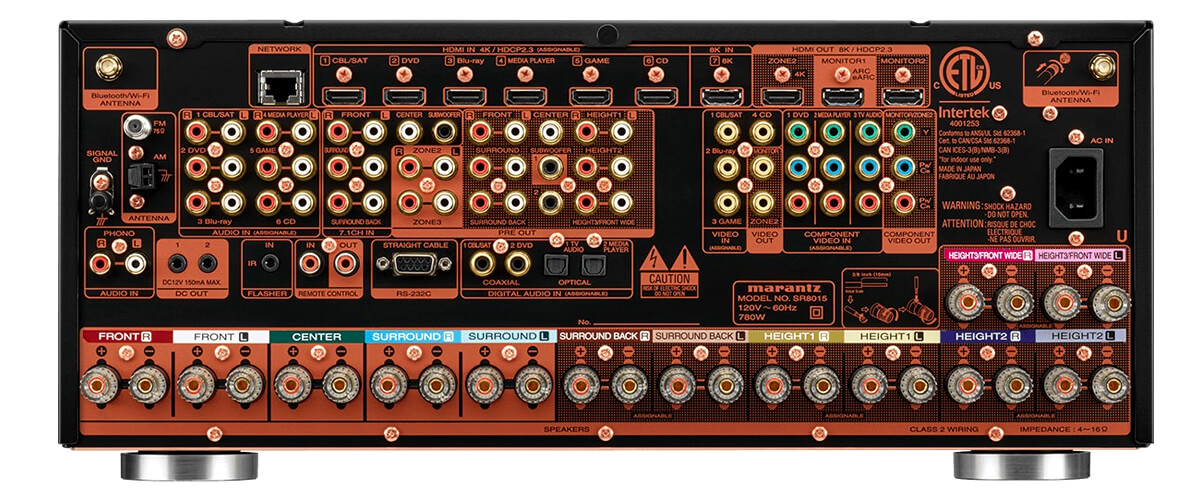
And since Marantz’s price is slightly higher than Denon’s, it should be noted that the brand always uses more expensive internal components than other companies. Its higher weight of 38.4 pounds evidences it. So, while overpaying for a seemingly identical receiver, you still get the highest quality construction you can think of. Still, unfortunately, this model only has one HDMI 2.1 port (like Denon), and it doesn’t work with all devices. And I would have preferred a phono input that supports the MC cartridge since I have a professional turntable.
To avoid repeating the features I described in my review of the AVR-X6700H, I will describe my feelings during the test. And I should start with the Audyssey MultEQ XT3 autocalibration system, which I neglected in my last Denon review. It simply delights me with its simplicity (but the Audyssey editing application is paid, which I’ll attribute to the disadvantages since the unit is expensive). They even made a special cardboard stand for the microphone, which made it incredibly easy. And for owners of Oled TVs, there is an option to avoid screen burn-in. Exceptional care.
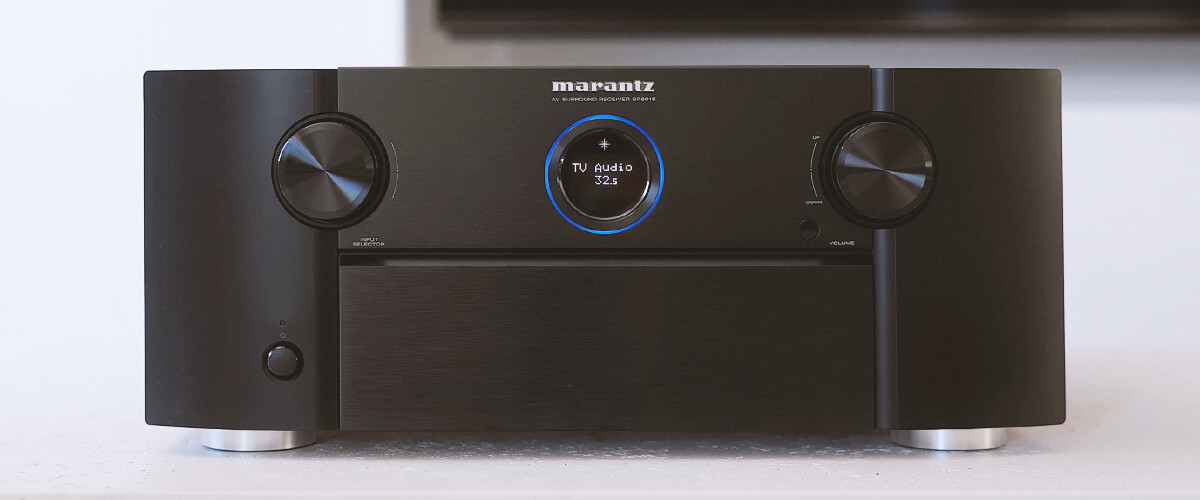
For this “monster”, I chose the movie Moonfall and was delighted. Even in the most powerful high-volume scenes, I didn’t notice the slightest delay, glitch, or inaccuracy. In Dolby Atmos, the dialogues against the rising rumble of the wind, and the muffled sound of Cosmos, in general, every scene was as realistic as possible, and the sound moved smoothly following the stated picture.
The Marantz SR8015 is, without a doubt, the best 11-channel amplifier for your home theater if you are willing to pay more. The sound is punchy, and the receiver’s capabilities will make it your companion for years.
Key specs
- Channels: 11.2.
- Power output: 140W/8 Ohm, 175W/6 Ohm.
- HDMI inputs/outputs: 8/3.
- Video functions: 8K/60Hz, 4K/120Hz pass-thorugh, upscaling to 8K.
- Bluetooth/Wi-Fi: yes/yes.
- Streaming services: AirPlay 2, Spotify, TuneIn, Deezer, Tidal, Netflix, Amazon Prime.
- Supports: GUI overlay on HDMI, HDMI eARC, HDMI CEC, HGL, HDCP2.3, HDR10+, Dynamic HDR, Dolby Vision.
- Surround sound: DTS:X, DTS:X Pro, DTS Virtual:X, DTS Neural:X, DTS HD Master, Dolby Atmos, Dolby Atmos Height Virtualization, Dolby TrueHD, Dolby Surround, IMAX Enhanced, Auro 3D.
Pros
- High-quality internal components and heavy-duty, rugged construction.
- Audyssey MultEQ XT3 auto-calibration is made with care and is easy to set up.
- Uninterrupted HEOS operation.
Cons
- Only one HDMI 2.1 port does not work with all devices.
- The Audyssey MultiEQ editing app is not free.
Pioneer Elite VSX-LX505
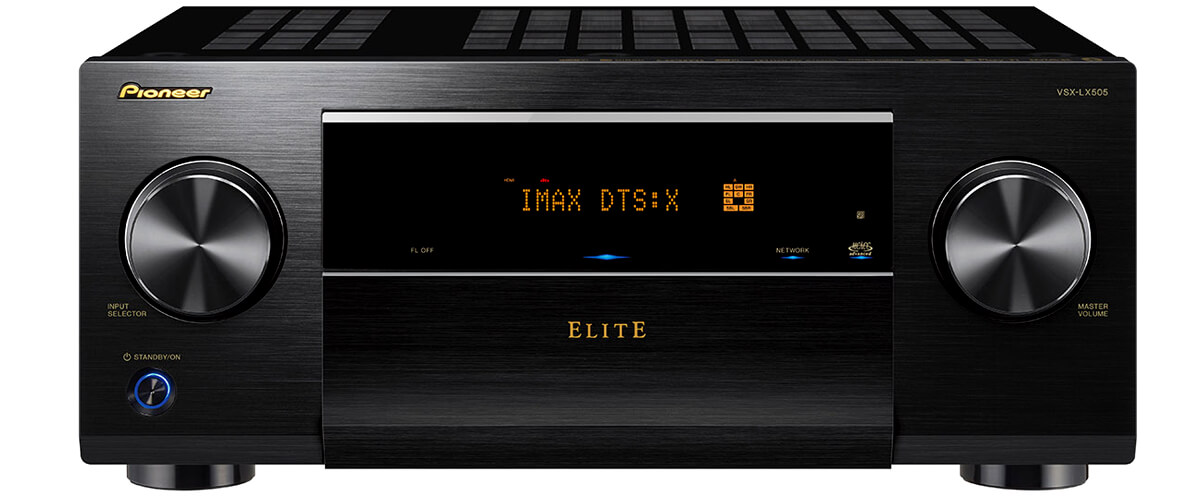
The Pioneer Elite VSX-LX505 is the most affordable receiver on my top list. As of today, it is the second after the brand’s flagship model, released in 2021. And it’s actually a 9-channel receiver, but it’s expandable to 11 channels.
You can already guess by the 28.7-pound weight that the manufacturer saved money on the design. Unfortunately, it’s also inferior to the Marantz and Denon in power, offering us 120 watts (8 ohms, 20Hz-20kHz, THD 0.08%, 2ch).
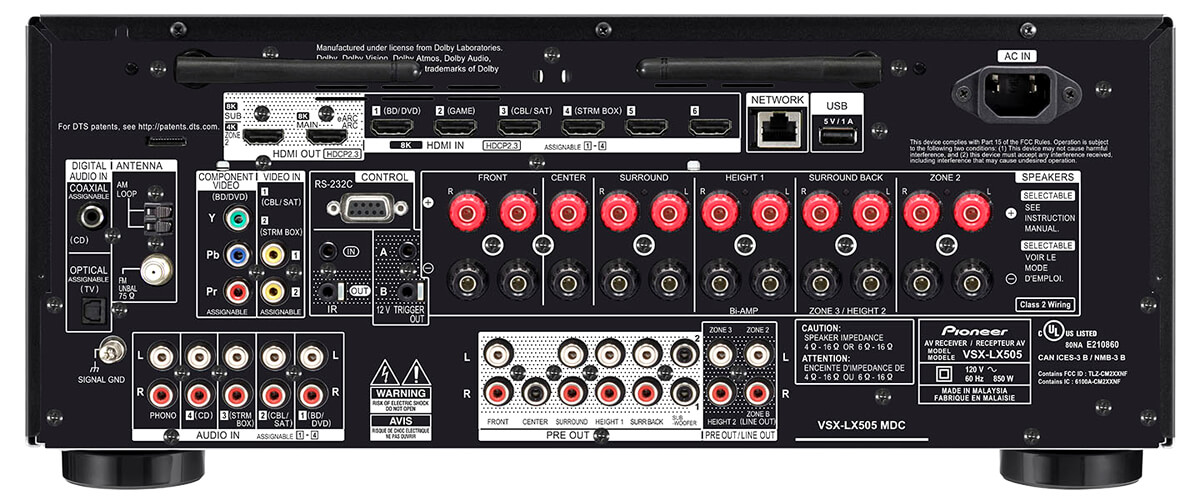
The VSX-LX505 has fewer HDMI ports (6/2) than the leaders on my list, yet they let you get a video of the same quality as them (supporting HDCP 2.3, ARC, eARC). And unlike the more expensive models on this list, all of its HDMI ports support actual 2.1 and playback content without any problems. I think this is a huge advantage.
The supported surround sound formats aren’t inferior, as the VSX-LX505 works with every technology except Auro-3D. It also broadcasts audio to 3 Zones (but not video) and has a Chromecast built-in.
As a bonus, the Pioneer Elite VSX-LX505 has DTS Play-Fi, which allows each member of your family to use their device independently.
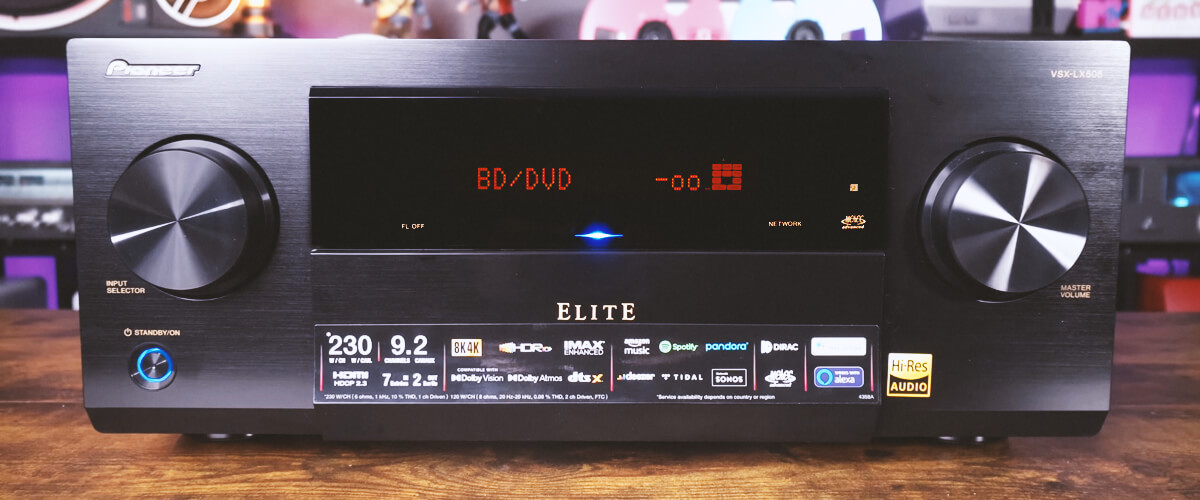
Surely the manufacturer wanted to do better by equipping the receiver with the advanced MCACC Dirac Live auto-calibration system, which takes a long time to set up. Those of you who are familiar with it will manage it quickly, but for an inexperienced user, the process can be a torment. Nevertheless, I was impressed with the result. I didn’t expect too much from it, but the sound surround picture left a pleasant impression, and I watched several movies of different genres.
If you want 11.2 surround sound and advanced surround sound technology for an affordable price, the Pioneer Elite VSX-LX505 is made for you. I’m happy to put it on par with the higher-end models for its great sound, advanced video performance, and support for numerous wireless options.
Key specs
- Channels: 11.2.
- Power output: 120W/8 Ohm, 230W/6 Ohm.
- HDMI inputs/outputs: 7/2.
- Video functions: 8K/60Hz, 4K/120Hz pass-thorugh, upscaling to 8K.
- Bluetooth/Wi-Fi: yes/yes.
- Streaming services: AirPlay 2, Spotify, TuneIn, Deezer, Tidal, Netflix, Amazon Prime.
- Supports: HDMI ARC, HDMI eARC, HDMI CEC, HDCP2.3, HGL, HDR10, HDR10+, Dolby Vision.
- Surround sound: DTS:X, DTS Neural:X, Dolby Atmos, DTS HD Master, Dolby Atmos Height Virtualizer, Dolby TrueHD, Dolby Digital Plus, IMAX Enhanced, Dirac Live.
Pros
- The bass from my subwoofers sounded much wider and deeper than on similar models.
- DTS Play-Fi makes sure each unit operates independently of the others.
- After the correct Dirac Live setup, the soundstage is even better, and the bass sounds deeper as the subwoofer’s response is more flattened.
Cons
- Fewer HDMI ports than favorites.
- Difficult, though advanced, Dirac Live audio setup.
Yamaha RX-A8A
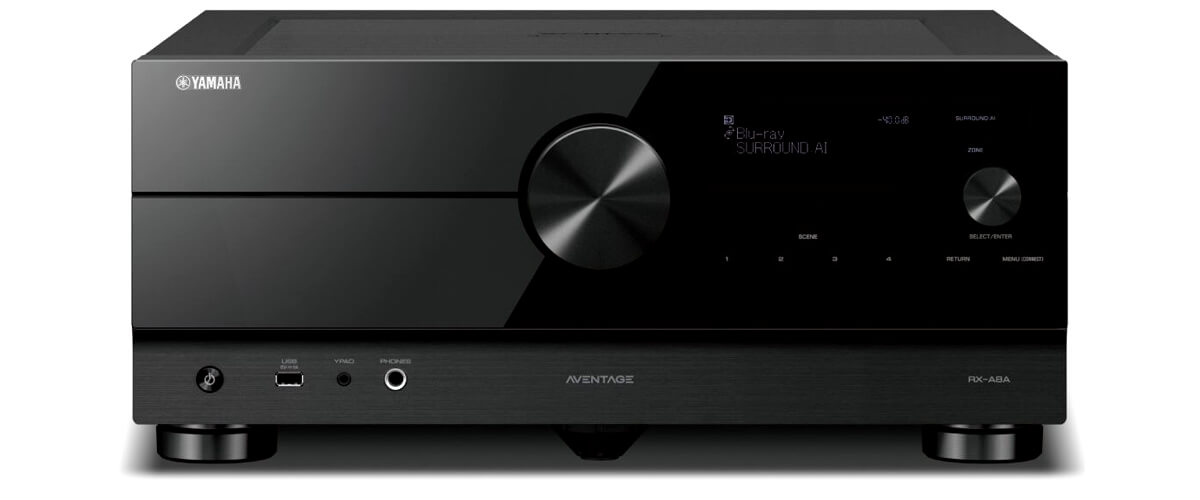
Well, it’s time to review my selection’s most powerful high-end AVR, which claims 150 watts (8 ohms, 20Hz-20kHz, 0.06% THD, 2ch). At as much as 47.2 pounds, this Yamaha RX-A8A is the company’s flagship model today, and along with the Marantz and Denon, offers us all the latest video and surround sound formats. But, of course, its price is comparable to theirs. It’s just a bison among bears, let me tell you. By the way, for extra anti-resonance, the manufacturer placed a fifth leg in the center of the front panel on the bottom of the unit. I must also mention its extraordinary design with a flat, glossy front panel.
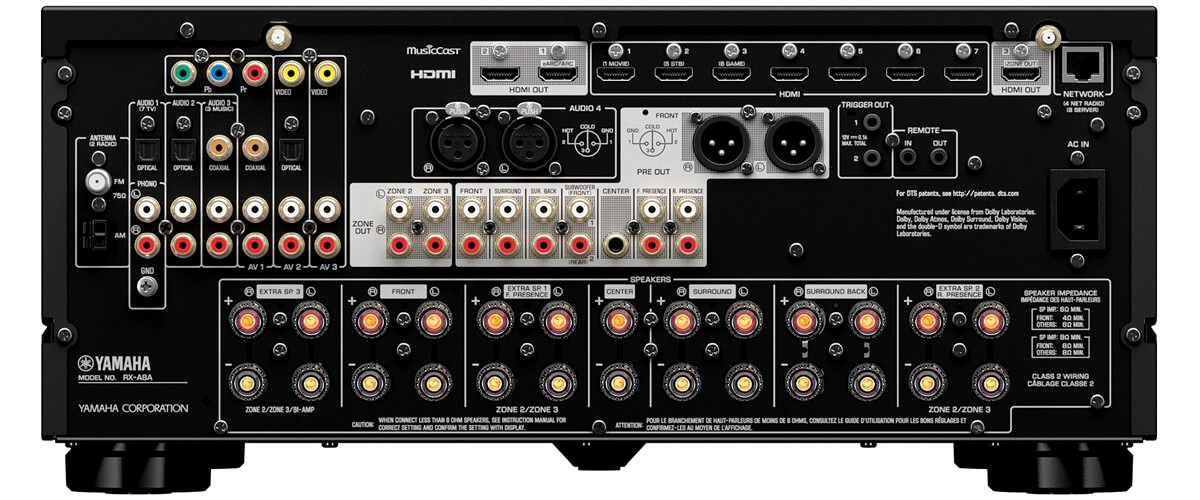
Of the RX-A8A’s unique features, I should mention the Multi-Room video streaming to 4 Zones. Can you imagine? If you have a large family with different preferences – take it and do not think. And also the unique CINEMA DSP HD3 technology, which provides high-quality concert sound right in your home. Artificial intelligence (AI) technology is built into the DSP, which can analyze scenes by itself, highlighting dialogue, backgrounds, and specific effects and optimizing surround sound in real time.
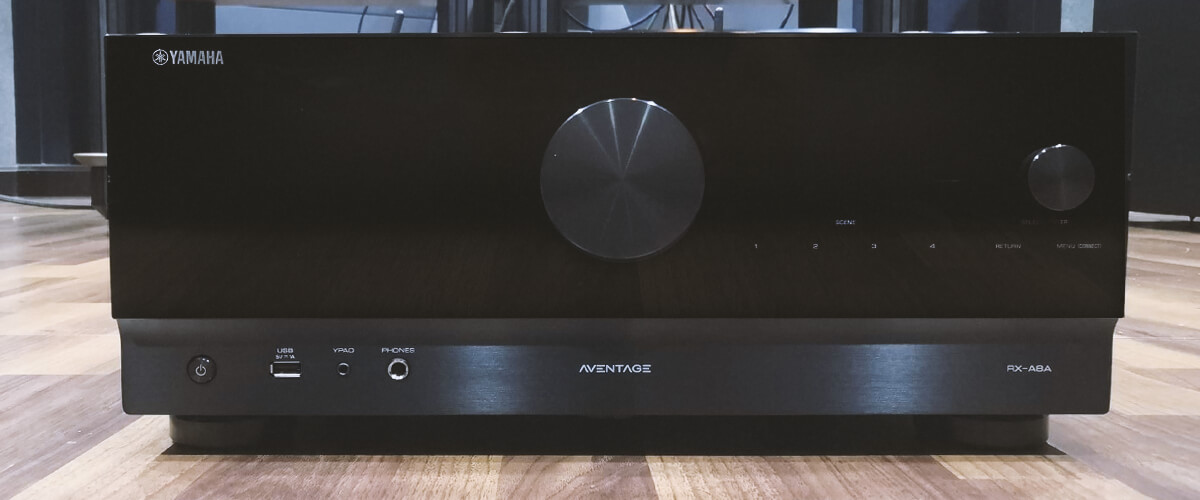
Superior YPAO’s R.S.C. calibration system with 3D, multi-point sensing, accurate E.Q., and bass mode is one of my favorites. It simply requires no effort on your part. And the receiver sounds amazing, although I note every time that, unlike the incredibly warm Denon, the Yamaha has a cold specific sound that may or may not be loved. I chose The Greatest Showman for it because I wanted to try out Surround:AI and was left totally enthralled. The clear, in places transparent natural sound from each musical instrument, the slightest detail of the rustling of the long dresses, the air movement as she flew under the dome, and the incredible performance of the Diva played by Rebecca Ferguson all merged into a vibrant Circus holiday composition right in my home.
The Yamaha RX-A8A will give you an amazing surround sound experience. It’s the best 11.2 Atmos receiver that, thanks to its unique technology, will become an asset to your home theater if only you love its subtleties.
Key specs
- Channels: 11.2.
- Power output: 150W/8 Ohm.
- HDMI inputs/outputs: 7/3.
- Video functions: 8K/60Hz, 4K/120Hz pass-thorugh, upscaling to 8K.
- Bluetooth/Wi-Fi: yes/yes.
- Streaming services: AirPlay 2, Spotify, TuneIn, Deezer, Tidal, Netflix, Amazon Prime.
- Supports: HDMI ARC, HDMI eARC, HDMI CEC, HDCP2.3, HDR10+, Dolby Vision.
- Surround sound: DTS HD Master, DTS:X, DTS Virtual:X, Dolby Atmos, Dolby TrueHD, Dolby Digital Plus, Dolby Surround, Surround:AI, Cinema DSP, YPAO, Auro 3D.
Pros
- The most powerful receiver on the list with 150W per channel.
- Multi-room video for 4 Zones.
- Unique CINEMA DSP HD3 technology for concert sound.
- Artificial intelligence (AI) technology built into the DSP analyzes and optimizes surround sound in real-time.
Cons
- The receiver has a peculiar cold transparent sound that may not suit all users.
Sony STR-AZ5000ES
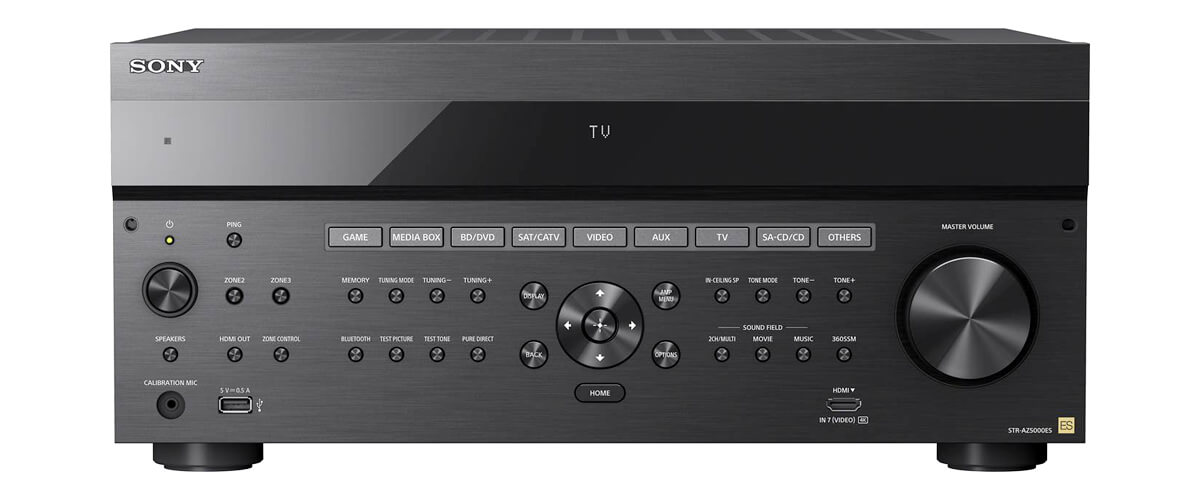
The last one in my review is AV receiver 2023, and it is Sony STR-AZ5000ES at a slightly higher price than Pioneer Elite VSX-LX505. Nevertheless, unlike the same Pioneer, it is a full-fledged 11.2 channel receiver. It has more power too, and it is 130W (8 Ohms, 1kHz, THD 0.9%, 2ch) as well as its weight of 42.3 pounds which says about its greater stability and quality of components used in construction. But when a manufacturer saves one thing for this price, it is slightly inferior to more expensive models in another.
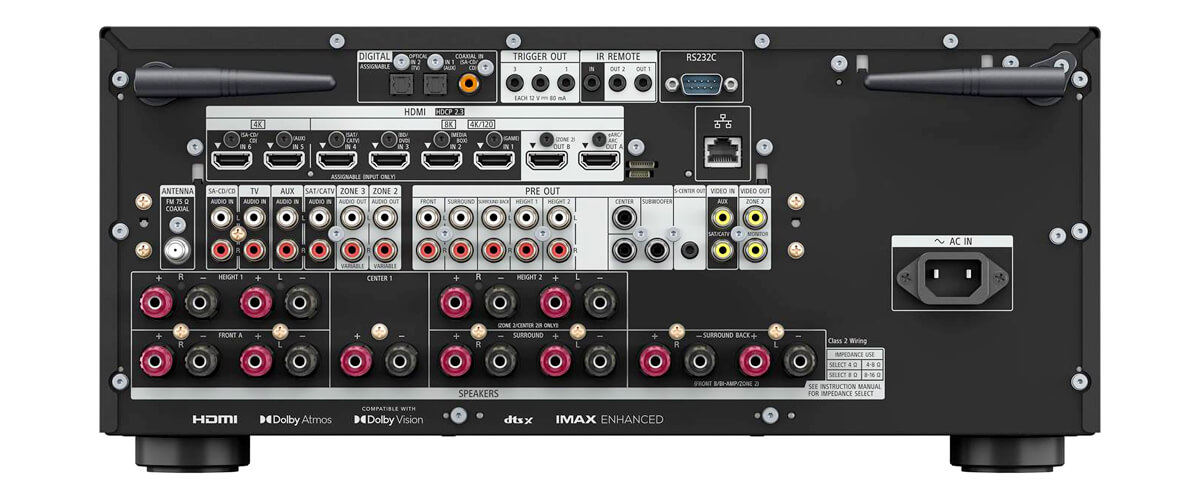
Well, the Sony STR-AZ5000ES falls short of the chart leaders not only in design (all its buttons are not hidden like the others, but are outside and will get clogged with dirt), but also in the number of connections and offers 7/2 HDMI ports, one of which supports HDCP 2.2. And despite supporting resolutions 4 and 8K, there is no upscaling function, nor is the HDR10+ format. As for surround sound, the receiver supports Dolby Atmos and DTS:X but nothing else. However, if you choose reliability and quality at a reasonable price, these are not critical flaws.
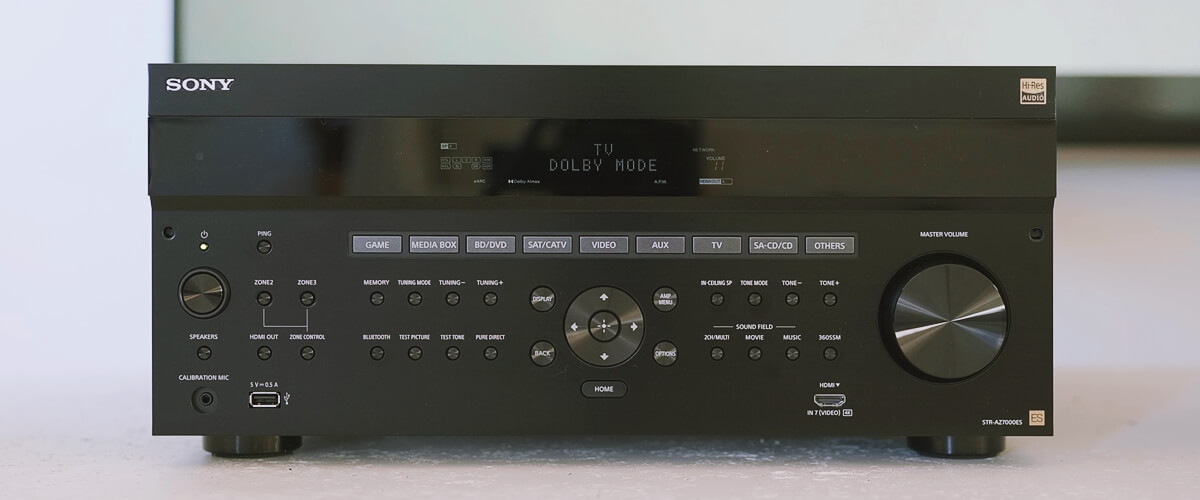
Sony also has no phono input, and the Multi-Room broadcast is only for 2 Zones. But it can be integrated into your home ecosystem if you buy special devices separately (e.g., Sonos port).
Sounds great. I have tried streaming services, Chromecast built-in, and Bluetooth streaming. I also watched several movies of different genres to find outright flaws, but that didn’t happen. So, I have no complaints about this AVR performance.
Sony STR-AZ5000ES is a worthy alternative to more expensive models, which supports major modern video formats and surround sound and quality audio playback from any source. By choosing it, you pay for reliability and a no-frills warranty. It’s a great, simple, but reliable SUV among sports cars.
Key specs
- Channels: 11.2.
- Power output: 140W/8 Ohm.
- HDMI inputs/outputs: 6/3.
- Video functions: 8K/60Hz, 4K/120Hz pass-thorugh, upscaling to 8K.
- Bluetooth/Wi-Fi: yes/yes.
- Streaming services: AirPlay 2, Spotify, TuneIn, Deezer, Tidal, Netflix, Amazon Prime.
- Supports: HDMI ARC, HDMI eARC, HDMI CEC, HDCP2.3, HDR10+, Dolby Vision.
- Surround sound: DTS HD Master, DTS:X, DTS Virtual:X, Dolby Atmos, Dolby TrueHD, Dolby Digital Plus, Dolby Surround, MAX Enhanced.
Pros
- A full-featured 11.2-channel receiver at an affordable price.
- Heavier reliable construction than some models.
- Switching sources takes about 10-15 seconds and goes smoothly without any visual or audio glitches.
- If you have a modern Sony TV, using this receiver gives you a few extra features.
- 360 spatial mapping works incredibly and reveals the sound scene in an entirely new way.
Cons
- Less connectivity than in other models.
- Does not support surround sound in various formats other than Dolby Atmos and DTS:X, which loses out to the other reviewers.
- A small and not very handy remote control.
Calibrate speakers for optimal audio performance with 11.2 receiver?
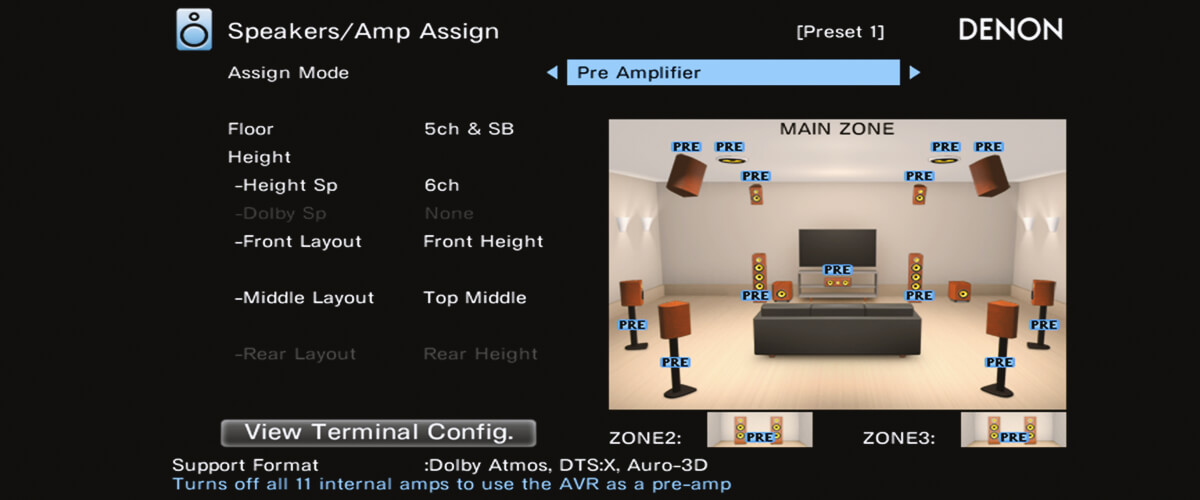
Calibrating your speakers is important for getting better sound quality from your 11.2 receiver and may seem like a complicated process. But don’t worry that you can’t handle such a complex system. I offer you the following step-by-step instructions for home calibration, following which you will quickly get the job done:
- Position the speakers according to the desired height and angle relative to your location as a viewer. Then connect the speakers to the receiver.
- Adjust the speaker levels using a sound pressure level meter (SPL) or smartphone app, then adjust the speaker volume levels in the receiver’s settings menu (usually 75 dB).
- Set the speaker distances, then enter these measurements in the receiver setup menu.
- Make sure the speakers are in phase and that the polarity is correct.
- Adjust the bass control in the receiver setup menu (usually 80 Hz).
- Run the room correction program. (Audyssey, Dirac, or YPAO) according to the included instructions.
- After calibration, listen to various materials to evaluate the overall sound quality. Use the built-in equalizer or a separate graphic equalizer.
Voila! Your home theater is ready. Enjoy your viewing experience!

